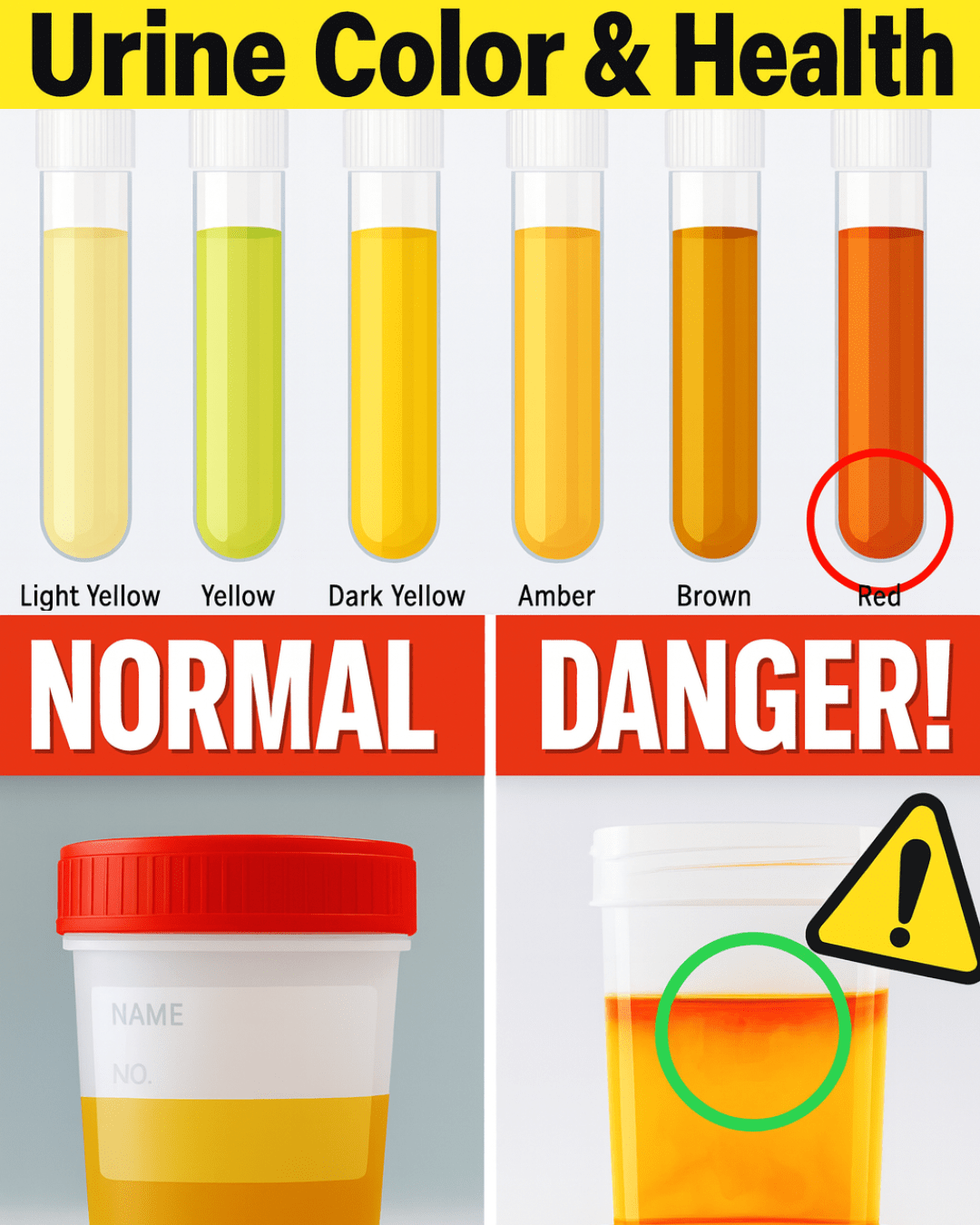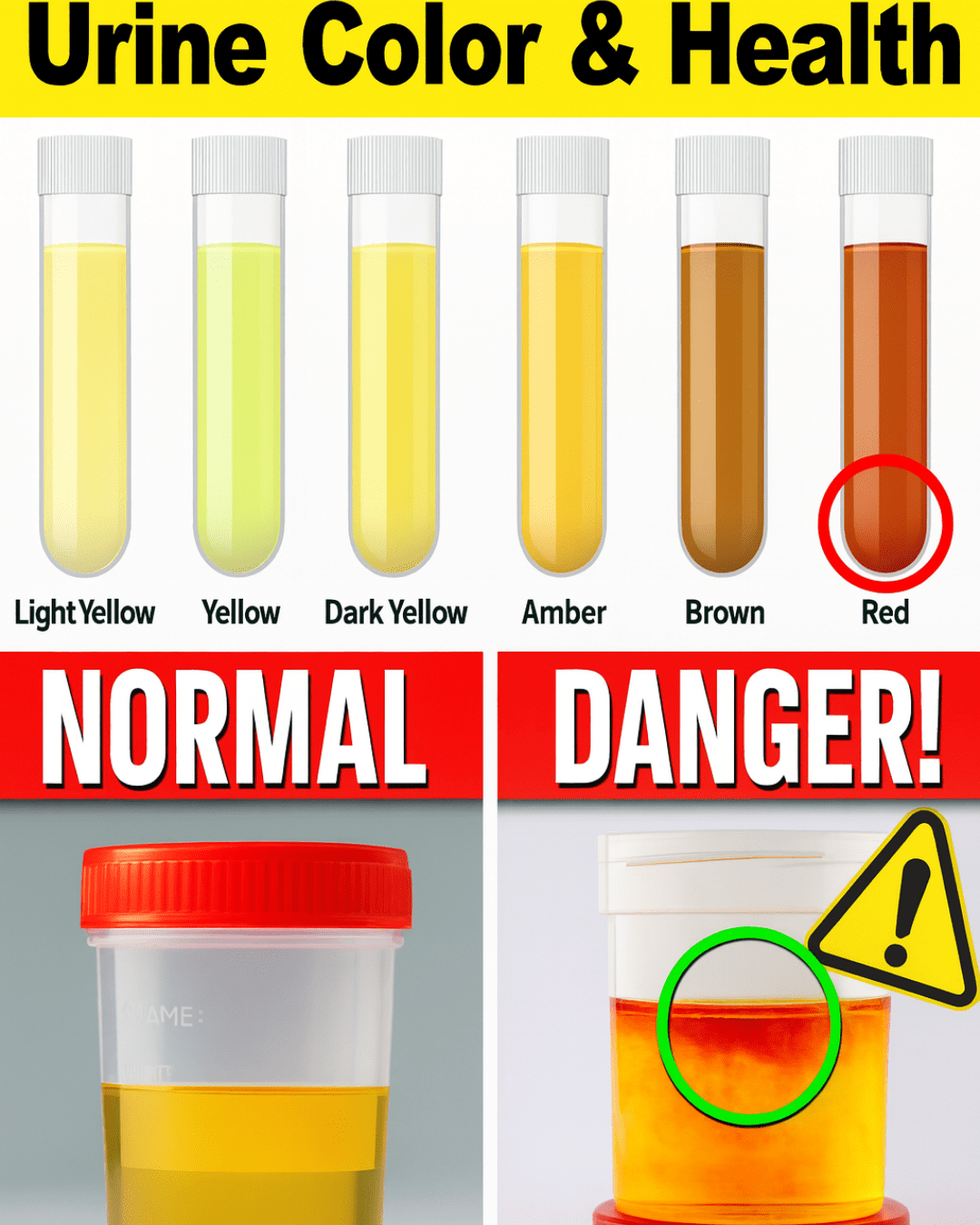Urine is not merely a waste product; it is the simplest, most direct diagnostic tool your body provides every day. The color, clarity, and even the smell of your urine offer immediate, invaluable insights into your hydration levels, dietary habits, and, most critically, the function of vital organs like your kidneys and liver. Ignoring persistent or unusual changes in this fluid is a dangerous oversight.

Your health depends on catching subtle warnings early. Read on to unlock the complete Urine Color Guide, understand what each shade—from pale yellow to dark brown—is telling you, and learn the critical symptoms that demand you seek medical attention immediately.
🌈 The Urine Color Spectrum: What Each Shade Signals
1. ☀️ Clear or Pale Yellow (The Ideal Zone)
- What it Means: You are perfectly hydrated. This light, straw-colored shade indicates that your kidneys are efficiently filtering waste while maintaining an excellent balance of water and electrolytes.
- A Word of Caution: If your urine is consistently completely clear (like pure water), you may be overhydrated. While generally harmless, excessive water intake can dilute essential electrolytes (sodium and potassium), vital for muscle and nerve function.
2. 🟡 Dark Yellow or Amber (The Dehydration Warning)
- What it Means: Your body urgently needs fluids. When you are dehydrated, your kidneys conserve water, leading to a higher concentration of waste products (urochrome) in the urine, resulting in a darker color.
- Action Plan: Immediately increase your water intake. Be particularly vigilant after strenuous exercise, during hot weather, or after consuming diuretic beverages like coffee or alcohol.
3. 🧡 Orange Urine (The Medication Marker)
- What it Means: Orange urine is often surprising, but usually benign and linked to external sources.
- Possible Causes:
- Medications: Common culprits include antibiotics (like rifampin), drugs for urinary discomfort (phenazopyridine), and some laxatives.
- Diet: High intake of foods or supplements rich in beta-carotene (carrots, sweet potatoes, high-dose Vitamin C).
- 🚨 When to Seek Help: If orange urine is accompanied by pale or clay-colored stools or yellowing of the eyes and skin (jaundice), seek medical attention immediately. This is a severe red flag for liver or bile duct obstruction.

4. 🔴 Pink or Red Urine (The Hematuria Alert)
- What it Means: This is the most alarming color, though it has both harmless and serious causes.
- Harmless Causes: Eating naturally pigmented foods like beets, blueberries, or rhubarb.
- Serious Causes (Hematuria): If food is not the cause, red or pink urine indicates blood in the urine (hematuria), which may be a sign of:
- Urinary Tract Infections (UTIs)
- Kidney Stones
- Prostate enlargement or infection (in men)
- Bladder or kidney disease
- Action Plan: Do not ignore this symptom. Always consult a healthcare professional if you notice red or pink urine without a clear dietary explanation.
5. 🟢 Blue or Green Urine (The Rare but Curious Case)
- What it Means: This is rare and typically linked to external chemical agents.
- Possible Explanations:
- Medications: Certain antidepressants (amitriptyline) or anesthetics (propofol) can cause a blue or green tint.
- Dyes: Consumption of highly pigmented artificial food or beverage dyes.
- Infection: Rarely, a urinary tract infection caused by the bacteria Pseudomonas aeruginosa.
- Action Plan: If the color persists and you haven’t consumed anything dyed blue or green, consult a doctor to rule out an infection or metabolic concern.
6. 🟤 Brown or Cola-Colored Urine (The Extreme Danger Signal)
- What it Means: This is a severe warning sign that requires immediate medical attention.
- Potential Causes:
- Liver Disorders: Severe liver disorders, such as hepatitis or cirrhosis (indicating bile is backing up).
- Muscle Injury: Rhabdomyolysis—a dangerous condition resulting from muscle breakdown (often due to extreme exercise or trauma) that releases harmful proteins into the bloodstream.
- Severe Dehydration.
- Action Plan: If brown urine is accompanied by fatigue, nausea, or yellowing of the skin, seek emergency medical care without delay.
7. ☁️ Foamy or Cloudy Urine (The Protein/Infection Alert)
- What it Means: Indicates a change in urine content beyond normal waste.
- Possible Explanations:
- Infection: A Urinary Tract Infection (UTI), especially if combined with a strong odor or burning sensation.
- Protein: The presence of protein in the urine (proteinuria), which can be an early sign of kidney problems.
- Diet: Temporary cloudiness can be caused by excessive phosphate in the urine, often linked to diet.
- Action Plan: If cloudiness or persistent foam lasts for more than a few days, consult a doctor for a urinalysis to check for infection or kidney dysfunction.
👑 Final Thoughts: Your Simple Health Monitoring Tool
The color of your urine offers a simple, powerful, and free window into your body’s health. While temporary changes are often harmless, persistent or unexplained changes should never be ignored.
Key Takeaways:
- The Ideal: Aim for pale yellow urine—a sign of perfect hydration.
- The Red Flags: Red/Pink (Blood), Orange (Liver/Medication), Brown (Liver/Muscle Breakdown) all warrant professional attention.
- Consistency is Key: Pay attention to your body’s signals, stay hydrated, and use this simple color code to maintain a healthy urinary system and overall well-being.






